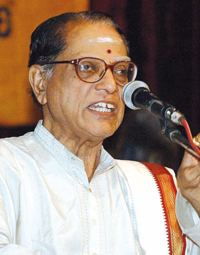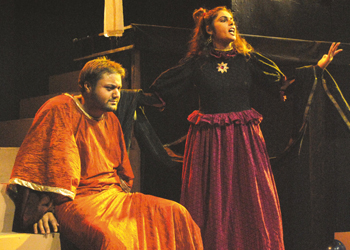COVER STORY
An adventurer and a reformer
R. Swaminathan

Almost every evening you could see him get down from the rear seat of a Tata Nano car, and walk with faltering steps as someone guided him to a front row seat at one of the concert venues in Chennai. The performance could be by an up-and-coming, little known or well-known musician. The old man could easily pass off as a pensioner spending the autumn of his life by treating himself to live classical music. This was vocalist-teacher-musicologist T.R. Subramanyam’s near-daily routine. His genial demeanour belied his reputation as an uncompromising upholder of the spirit of Carnatic music, acquired over the last six decades in the world of classical music.
To him the music afforded aesthetic pleasure through exploration of ragas, delight in rhythmic variations and joy at the literary efflorescence of the composers. His pursuit in music was wholesome and holistic.
Early years
Born into a large family in 1929, Subramanyam grew up in a middle-class home. His father Rajagopala Iyer, employed with Indian Mutual Life Insurance Ltd., was a music aficionado who invited musicians to his home wherever he was posted. He hosted the likes of Ariyakudi, Semmangudi and Madurai Mani who partook of the warm hospitality extended by his family. As the family moved wherever Rajagopala Iyer was posted, Subramanyam and his siblings were to be schooled in several towns like Mayavaram, Kumbakonam and Tirunelveli. At Mayavaram he was tutored by Sivarama Iyer, a disciple of Poochi Srinivasa Iyengar. Later at Tirunelveli his teachers were A.D. Rajagopala Iyer and Perungulam ‘Gavai’ Seetarama Bhagavatar. He and his elder sister Radha received music training at home. According to him, his sister – now 86 – was talented and had an enviable, melodic voice. TRS regrets that his sister’s music career did not take off after her marriage. An event from boyhood days of singing as narrated by him is indeed fascinating.
HERITAGE
The divine dancer in miniature
Chithra Madhavan

The best-known, most eye-catching temple of the Chola era is the Brihadeeswara (Rajarajeswaram) temple in Tanjavur, built in the reign of Rajaraja I (985 – 1014 AD). Close behind come the outstanding Chola architectural marvels at Gangaikondacholapuram, Darasuram and Tribhuvanam. Not many are aware of innumerable other temples, big and small, dotting villages, towns and cities across Tamil Nadu and some other parts of south India as well, belonging to the reign of various Chola monarchs, before and after Rajaraja I. Among such less-known Chola temples is one dedicated to Siva called the Brahmapureeswara temple in Pullamangai, a small village near Pasupati Kovil, approximately twenty kilometers from Tanjavur and also accessible from Kumbakonam. It is one of the most remarkable temples of the early Chola era. The original name of the temple, according to the stone epigraphs etched on its walls, was Tiru Alandurai Mahadevar.
A Tamil inscription in this temple, datable to 918 AD, belongs to the reign of Parantaka Chola I (907 – 955 AD). It indicates that this temple was built early in the reign of this monarch or perhaps even earlier, in the reign of his father Aditya Chola I (c. 871 – 907 AD). This temple has undergone many structural changes over time. The central sanctum sanctorum (garbha griha) and the mandapa in front (ardha mandapa) are from the Chola epoch, while other additions like the front mandapa (mukha mandapa) were added in later periods.
As in some other early Chola temples, many sculptures on the outer walls of the main sanctum sanctorum in the Pullamangai temple, are miniatures – not more than a few centimetres in height. They depict various interesting episodes from the Ramayana, Mahabharata, various manifestations of Siva, incarnations of Vishnu and also musicians and women in dance poses.
THEATRE
Punjabi theatre fest in the capital
Shrinkhla Sahai

The curtain rose to a vibrant four-day Punjabi theatre festival in the capital amid the uproar on Delhi University’s move to remove the Punjabi language as a main subject in its affiliated colleges from this academic session. A galaxy of scholars and litterati of Punjabi have emerged from the university over the years and this step is seen as a major setback for the intellectual, academic and artistic life revolving around the language.
With new norms in place, Punjabi can be taught only as a minor subject and that too from the second year of graduation. Punjabi, which is the second officially recognised language of the capital, was earlier taught as a compulsory subject in 15 colleges, whereas now only three affiliated colleges can do so under the new four-year undergraduate programme. With growing resentment and protests across Punjab and Delhi regarding this decision of the university authorities, the Punjabi Academy collaborated with the Theatre and Television Department of Punjabi University, Patiala, to stage their best productions at the festival during 2-5 September 2013.
Celebrating a century of existence, modern Punjabi theatre has its roots in realism initiated by the prolific work of Ishwar Chander Nanda and Norah Richards in 1913. Now in its fourth wave, Punjabi theatre has deepened its roots in rural areas and continues to reflect upon, critique and reform the social reality in the state.
ART-STAMPS
Patron of music and dance
S. Sankaranarayanan

T.T. Krishnamachari, popularly known as TTK, is hailed as one of the makers of modern India. He was instrumental in building the basic economic and industrial infrastructure of the country. As a member of its drafting committee, he left his mark on the Constitution of India.
TTK had wide ranging interests – from economics to hospitality, horticulture and medicine. He was a lover of books as well. Above all he was a connoisseur of music and dance.
The Music Academy in Chennai owes its magnificent auditorium to his dedicated efforts. He was also responsible for extension of the conferment of Sangita Kalanidhi award to women artists, the first recipient being M.S. Subbulakshmi in 1968.
Stamp on TTK
The Department of Posts issued a commemorative postage stamp in honour of TTK on 31 December 2002 on the occasion of the platinum jubilee of the Music Academy, Madras. The multi-coloured five-rupee stamp, perf 13.5, was printed on Matt Chrome paper by photo offset process at Calcutta Security Printers.


